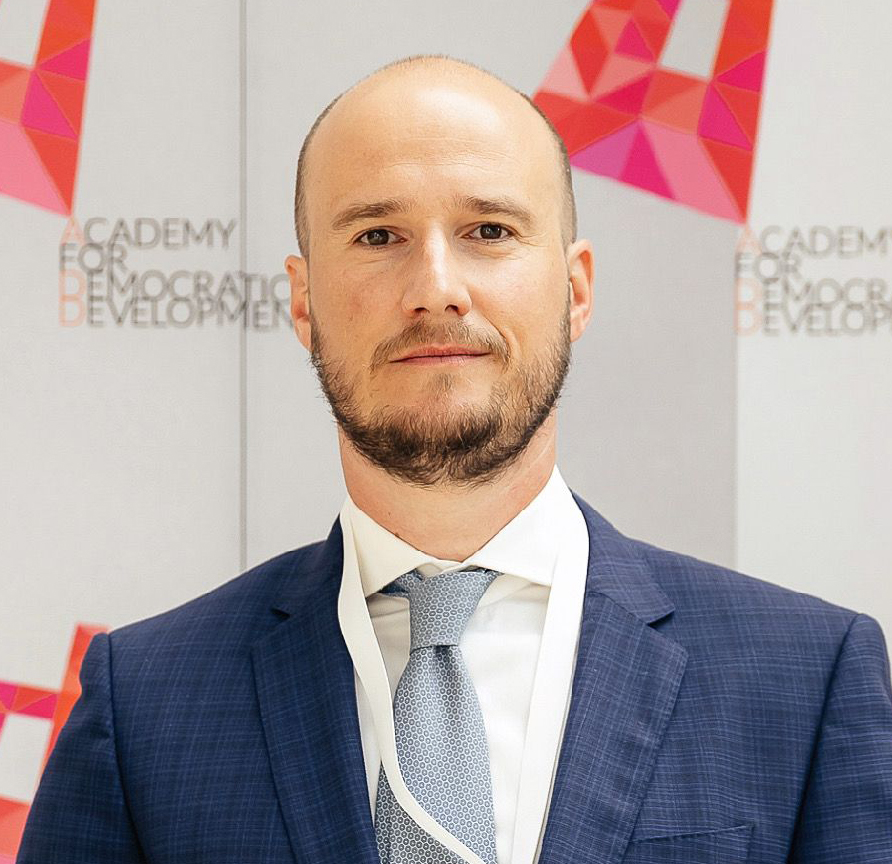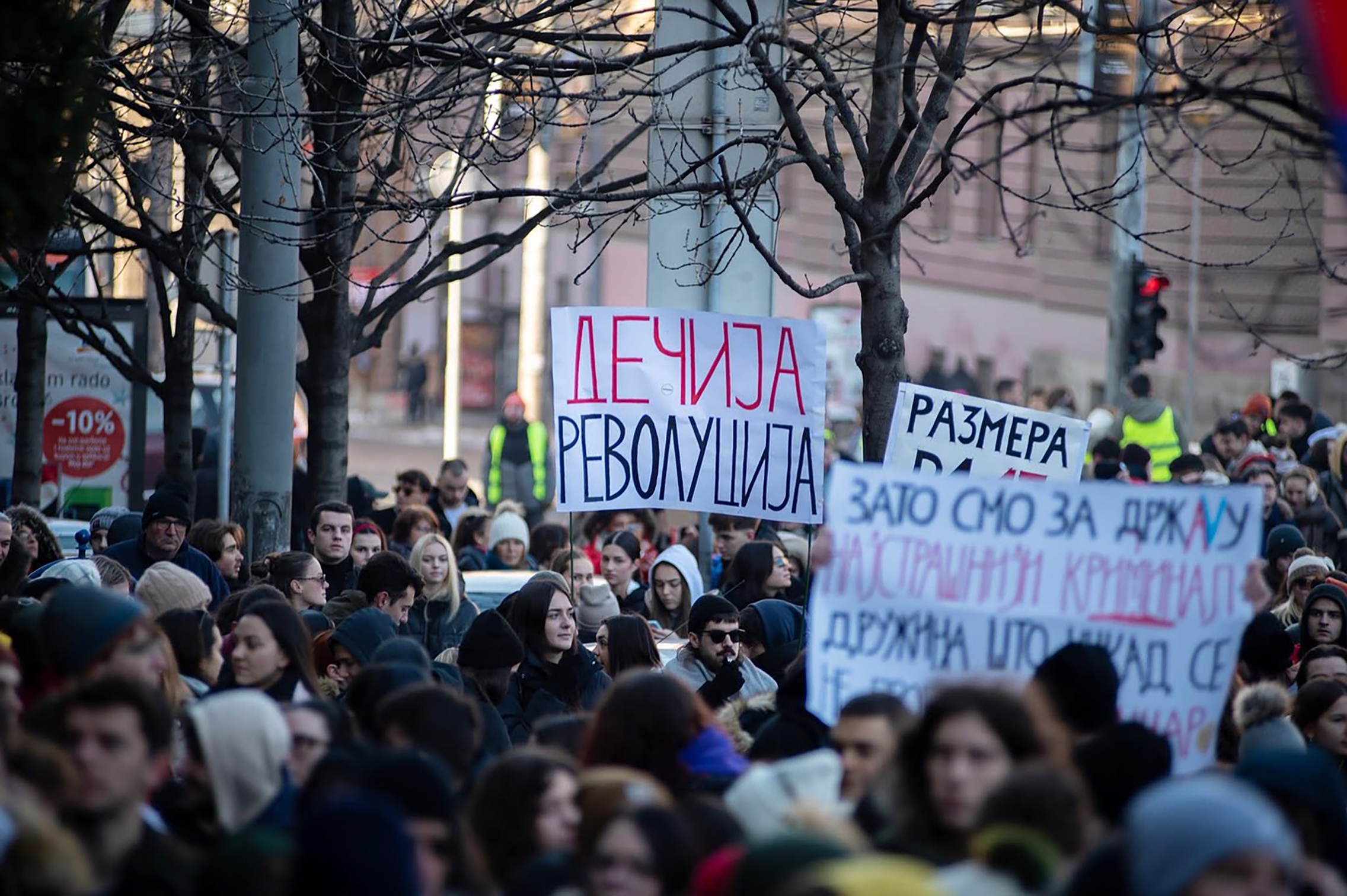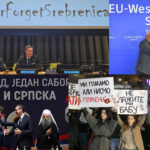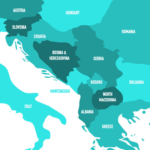The History of Vučić’s Rule in Serbia
After twelve years of Vučić’s autocratic rule, Serbia once again finds itself on the brink of dictatorship. Vučić has dragged the country back from democracy into a pre-political state, reminiscent of the dark era of rule by the “Butcher of the Balkans,” as European media referred to Slobodan Milošević, a war criminal and Serbia’s president during the 1990s.
In the final years of Milošević’s regime, Vučić served as his Minister of Information, notorious for enacting the most repressive media law in Europe’s post-war history. At the time, the regime showed no hesitation in orchestrating assassinations of journalists and opposition leaders.
The democratic revolution of 2000 that ousted Slobodan Milošević pushed Vučić into political obscurity, where he waited for an opportunity to return to power. His chance came in the aftermath of the global economic crisis, which further devastated Serbia’s already fragile economy and deepened poverty among its citizens. This period was also marked by the failures of the democratic government to resolve the Kosovo issue and numerous corruption scandals. Exploiting these circumstances, Vučić successfully maneuvered his way back to the pinnacle of Serbian politics.
In an effort to politically win over Western governments, against which he had fought during the 1999 NATO intervention, Vučić—a former radical nationalist—pledged to resolve the Kosovo issue and normalize relations between Belgrade and Pristina, as well as to offer unconditional cooperation with the EU on migration. The West, particularly German Chancellor Angela Merkel, was enthusiastic about the idea of having found a leader who could deliver “stability” to the Western Balkans by resolving the Kosovo question and shielding the continent from migrants.
Vučić presented himself to the world as an ideological and political penitent, claiming to have abandoned his former beliefs and embraced the values of the European Union, which he had opposed for most of his life and political career. He cultivated the image of a reformer with a pro-European narrative, promising to modernize Serbia and provide a lasting solution to the Kosovo issue.
Domestically, Vučić launched a brutal campaign against political opponents, including the arrest of over 150 senior officials of the Democratic Party. By doing so, he demonized and weakened the strongest pro-European and the only genuinely democratic party in Serbia, which had led the country’s European integration process from 2000 to 2012. Simultaneously, he intensified anti-European and nationalist rhetoric regarding Kosovo, outwardly justifying it as merely a tool for internal political manipulation.
He systematically dismantled independent institutions and violated the Constitution, consolidating power to a degree rarely seen even among the most notorious dictators. The European Union, however, turned a blind eye to blatant violations of fundamental political and human rights in Serbia, content with Vučić’s promises to resolve the Kosovo issue and control the migrant route through the Balkans. In this way, Vučić established the foundations of “stabilocracy” in the Western Balkans, a model that enjoyed the full support of German Chancellor Angela Merkel.
Fear took hold of Serbia as Vučić systematically dismantled the Democratic Party, effectively eliminating any oversight role of the opposition. Simultaneously, he accelerated the fascistization of society, relativizing the gravest crimes of the wars in the 1990s, including the 1995 Srebrenica genocide. The more concessions he made internationally regarding Kosovo, the more he intensified anti-European rhetoric at home. Serbia was left without a credible opposition capable of challenging him, as society bent under the weight of fear and control.
Deceived Europe
Twelve years later, it became evident that Vučić had managed to deceive all key Western powers—Germany, the United Kingdom, the European Union, and even the United States. Relying on his partnership with Chancellor Merkel and his traditional ties with Putin, he consolidated and centralized his personal power, not only in Serbia but across the broader Western Balkans region.
He skillfully manipulated both U.S. administrations, Trump’s and Biden’s, by promising a resolution to the Kosovo issue—a promise he never fulfilled. Despite Western investments, he remained firmly aligned with Russia’s orbit as an open supporter of Vladimir Putin’s policies. Simultaneously, Serbia became the first country on the European continent to adopt Chinese weaponry and information technology. Corruption in Serbia has reached alarming levels, comparable to those in Russia and Belarus, while the country continues to drift further away from European standards in every segment of society.
Support for Serbia’s European integration has dropped below 38%, the lowest level in the Western Balkans region. During Vučić’s rule, the political assassination of Oliver Ivanović, a prominent opposition leader among Kosovo Serbs, took place, with evidence pointing directly to Aleksandar Vučić’s closest associates. Additionally, Serbia was implicated in a terrorist attack in Banjska, Kosovo, orchestrated by Serbian security services and involving Milan Radoičić, a close ally of Vučić.
One of the biggest scandals was the discovery of the largest marijuana plantation in Europe, directly linked to Vučić’s brother, Andrej Vučić. Irregularities in every electoral process since 2014, combined with a series of criminal activities and corruption scandals, will remain defining elements of Vučić’s political legacy.
At the outset of Russia’s invasion of Ukraine, Vučić adopted a “neutral” stance, which effectively amounted to direct support for Putin, as he anticipated a swift Russian victory. During Europe’s greatest crisis since World War II, he openly undermined the European Union’s common foreign and security policy while maintaining a close relationship with Putin.
Vučić is the absolute master of Serbia’s national broadcast media, appearing over 350 times on national television in 2024 alone, including 28 times in December. His power is absolute at every level of the state. He has surrounded himself with a tight circle of oligarchs and criminals whose wealth is measured in billions of euros, amassed through smuggling, arms trafficking, drug trade, and money laundering. His power and influence have become a source of fear, not only within Serbia but across the entire Western Balkans.
Vučić skillfully manipulated every sector of society—controlling the Church, intelligence services, a significant portion of the intellectual elite, world-renowned Serbian athletes, public figures, and even a large part of the civil sector. He ruthlessly dominated anything that could threaten his power. To be fair, there were exceptions.
When it seemed that Vučić had become an unavoidable fate for Serbia—one against which resistance seemed futile and resignation inevitable—a tragedy struck. On November 1, 2024, at 11:52 AM, the recently reconstructed canopy at the Novi Sad train station, in Serbia’s second-largest city, collapsed. Fifteen people lost their lives.
The Collapse of the Train Station Canopy
Immediately after the tragedy, the state television refused to report on the incident throughout the day, only broadcasting the news in the evening. Following his usual pattern, Vučić quickly moved to spin the narrative, shifting the blame away from the government. He claimed that the collapse was caused by the old canopy, which, according to him, hadn’t been reconstructed in over 60 years. This was soon exposed as a blatant lie. In an attempt to defuse the situation, he announced that those responsible would be identified. However, later that same evening, the authorities ordered the removal of all evidence from the site, effectively preventing a thorough investigation into the causes of the collapse.
However, even Vučić’s manipulations could not quell the anger of Novi Sad’s citizens. In protest, thousands took to the streets, declaring that what happened in their city was not merely an accident but a murder. Citizens openly accused the government, asserting that corruption within Vučić’s inner circle led to the collapse of the canopy, claiming 15 lives.
The claim that the collapse was not an accident but a murder shook Serbia to its core, awakening a fear for loved ones that surpassed the longstanding fear of the regime. The entire nation rose in solidarity with Novi Sad.
The regime, through its media machinery, attempted to frame the tragedy as an opportunity exploited by the opposition for political manipulation, while promising a swift response from the prosecution and police to identify those responsible. However, instead of prosecuting the true culprits, the prosecution began arresting opposition leaders and activists, further deepening public outrage across the country. Why didn’t the corrupt prosecution identify the responsible parties? Because any serious investigation would inevitably lead to the heart of the regime’s criminal network and companies linked to Vučić’s brother, Andrej Vučić.
The Emperor Has No Clothes
Vučić assumed that the already weak and unpopular opposition, discredited in the eyes of the public through years of propaganda, would be enough to ensure the protests failed, as they had so many times before. And for a moment, it seemed he might be right—the opposition attempted to organize a protest in the capital, Belgrade, but it became evident that they were incapable of channeling the growing public discontent. The protest ended in failure.
And then, like a bolt from the blue, the students rose up. First in Novi Sad, followed by Niš and Belgrade, young people raised their voices and presented precise and achievable demands to the authorities. Their demands placed Vučić in an unenviable position—for the first time, he faced a credible and organized group of young people, rather than the weak opposition.
The students masterfully excluded Vučić from the dialogue, clearly stating that they refused to engage with him because, under the Constitution and the law, he is not authorized to address their demands. They exposed the incompetence of the Serbian government, labeling it as entirely dependent on Vučić, while accusing the prosecution of serving the regime directly and disregarding the law.
Faculty blockades quickly spread across Serbia. The students led the uprising, joined by high school students who began blocking gymnasiums and secondary schools. Citizens showed solidarity through mass traffic blockades lasting a symbolic 15 minutes, honoring the 15 victims.
In a desperate attempt to suppress the uprising, the Serbian government and Vučić deployed violent thugs against peaceful students and citizens blocking universities and roads. This brutal response by the regime triggered an even greater wave of dissatisfaction and bolstered support for the students across the country.
Another significant event in Novi Sad soon captured public attention. The city’s most renowned high school, Jovan Jovanović Zmaj, organized 15 minutes of silence in memory of those who perished beneath the collapsed canopy. The authorities sent provocateurs among the students, attempting to intimidate them back into class. However, standing in solidarity with the victims’ families was none other than the son of Serbia’s Prime Minister, Miloš Vučević—the same prime minister who, just days earlier, had labeled citizens participating in blockades as traitors to the state.
This news reverberated throughout Serbia, further exposing the regime. Vučić found it increasingly difficult to convince both his inner circle and his voters that he had the situation under control. The emperor has no clothes.
Students and High School Students
Why was this uprising such a surprise to many? At a time when the prevailing belief was that young people in Serbia were indifferent to action and resistance, and when it seemed almost impossible to reach them, the largest student uprising in Serbia’s history occurred. Many have already called it one of the largest in Europe.
If we look closely, over the past year or two, a completely new generation of students and young people in Serbia has been emerging, organized around several student and youth associations. Organizations such as Stav, Borba, Sviće, Masa, and many others have become prominent during protests over the past two years. Their primary goal is the fight for justice, the rule of law, and a democratic society.
These young people are present at every major protest across Serbia. They support farmers, educators, and professors targeted by media harassment under Vučić’s regime. They organize protests against lithium mining, respond to tragedies like the mass shooting at an elementary school where nine children lost their lives, and lead the fight against electoral fraud in 2024. At each of these events, they build their credibility, proving themselves on every critical issue in society.
Educated, eloquent, and remarkably brave, they rely on knowledge, values, and social media as their primary tools. Despite their relatively short activist careers, some have already faced imprisonment, surveillance, and harassment by Vučić’s secret services. They have also experienced setbacks, such as the failed protest against the regime over electoral fraud, but this has not deterred them. On the contrary, things are now accelerating with them—their determination and engagement are becoming unstoppable.
This generation of young activists effectively communicates with their younger peers, inspiring uprisings at universities across the country. Through their activism and public engagement, they set an example of how to fight for change. Their enthusiasm and dedication have awakened solidarity among students throughout Serbia. Unlike opposition parties, they have the support of younger generations and even teenagers. Their influence extends to high school students. They dominate the digital spaces that Vučić, with the help of his paid trolls, struggles to control—social media. Thus, a broad student front has been created, built on equality in decision-making, but without hierarchy or formal leaders.
And here we encounter yet another absurdity. Vučić, who controls 95% of Serbia’s media, is now facing a youth movement whose combined reach on social media—X, Facebook, Instagram, and TikTok—surpasses the total share of all his media outlets combined!
Vučić is in shock because he doesn’t know who he’s fighting. Opposite him, there is no single leader or group of figures he could easily discredit through his media machinery. Instead, he is confronted with thousands of students who debate and make decisions through the concept of direct democracy, in plenums.
Plenums exist at all blocked universities. They are attended by hundreds of students, each with an equal right to vote and participate.
Plenums, as spaces for the dissenting to organize and agree, remain untouchable by Vučić’s regime. While the government knows how to control official student parliaments as formal bodies within universities, it is entirely powerless against direct democracy and the plenums. The regime simply doesn’t know how to operate in an environment built on democratic principles.
Official student parliaments, aligned with the authorities, have become marginalized and utterly ineffective. In the end, it is the students who set the pace with their demands. For the first time, the regime and Vučić are on the defensive, stumbling from one mistake to another, with no answers to this challenge. The democratic nature of decision-making and the solidarity-driven actions of the students truly evoke the spirit of a democratic revolution.
An army of determined, composed, witty, and peaceful people, united by the ideals of justice and accountability. Not once have they explicitly stated they are against Vučić—in fact, they do not concern themselves with him at all, which only further infuriates the dictator. The students have created a trend: if you’re not at the protests or blockades, you’re not cool. And guess what—now everyone is there!
Professors were the first to join them, followed by farmers and educators. Soon after, actors, athletes, and numerous public figures lent their support. Together, the students laid the foundation for a democratic revolution.
The opposition recognized this and wisely decided to operate from the background, supporting the students without overtaking their movement. Meanwhile, support for the students began pouring in from across the Western Balkans, further strengthening their fight.
From One Mistake to Another
In his nervous attempts to maintain popularity and power, Vučić stumbles from one mistake to another. First, he deploys thugs to disrupt blockades, aiming to intimidate students and citizens. Then, he publicly defends drivers who ran over demonstrators blocking the roads. Shortly thereafter, he mobilizes criminals and public sector employees to physically confront protesters.
At one point, Serbia teetered on the brink of a full-scale civil conflict. However, every move Vučić makes backfires, deepening public outrage and expanding support for the uprising.
Following this, the regime launches a wave of arrests targeting opposition leaders, parliament members, students, and activists across Serbia. Citizens and lawyers quickly organize, demanding the release of all detainees in a show of solidarity. In the end, Vučić relents, and the court orders the release of those in custody.
In an attempt to win over young people, Vučić clumsily announced favorable housing loans on the public broadcaster, which was met with ridicule. The slogan “Students are not for sale” quickly became one of the defining messages of the protests.
Vučić’s missteps continued to pile up as events outpaced him. Seeking to demonstrate youth support, he organized a large gathering with “students and young people” in the country’s largest convention hall. However, images that soon circulated on social media revealed the truth—among the more than 3,000 attendees, there were no young people. Instead, the audience consisted of public sector employees and individuals from various parts of Serbia, mostly aged 35 to 55. This move further exposed Vučić’s fabricated popularity and the reality that he has no genuine support among young people. The situation became even more embarrassing when Vučić responded to the circulating photos by claiming they were fake and generated by AI.
Unwavering and determined, the students quickly organized a massive protest in Belgrade, drawing over 100,000 citizens. They made it clear that their demands remained unmet and that they would continue to insist on accountability and adherence to the law. Their primary demand—the prosecution of those responsible for the collapse of the canopy in Novi Sad—placed Vučić in an impossible position. His regime cannot fulfill this demand without endangering him and his closest associates.
Before the eyes of the entire nation, Vučić is losing this battle.
Conclusion
It is time for the international community to step in and withdraw its support for Vučić. The European Union now faces a clear choice: on one side are the students, embodying democratic values, and on the other is a dictator whose rule is regressing Serbia and endangering the stability of the entire region. Is the EU prepared to build its future with Vučić, a man who brings only crisis and conflict? With him in power, there will be no peace—neither in Serbia nor in the region.
Vučić’s strategy is clear—by creating problems in Bosnia, Kosovo, and Montenegro, he attempts to divert attention from domestic crises he cannot resolve. But the line has been crossed. Even his allies in the West can no longer expect either lithium for Europe’s industry or stability in the region.
The opposition has proposed a prudent solution: a transitional technical government to resolve Serbia’s crisis and ensure free and fair elections at all levels. This transitional government would also free the prosecution from political pressures, enabling it to prosecute those responsible for the deaths of 15 people at the Novi Sad train station, as well as address unresolved corruption cases from the past 12 years. Only then—elections.
Vučić’s political career is over. He has fallen, and it remains to be seen how this will end—peacefully or violently. It will be painful to witness his final attempts to manipulate the electorate, further divide society, and potentially provoke civil conflict. But every dictator meets the same end in the end.
Serbia stands at a crossroads, and it is the young people who are saving it. This is not just an uprising, it is a fight for fundamental values—democracy, the rule of law, and a future grounded in justice. The student uprising resembles a democratic revolution, aimed at nonviolent societal change that could finally bring Serbia into the fold of politically mature nations.
The struggle continues, but hope remains. Today, Serbia has the opportunity to build a society worthy of its citizens, thanks to young people who have demonstrated that courage and solidarity can indeed change the world.
The articles published in the “Opinions” column reflect the personal opinion of the author and may not coincide with the position of the Center
Balša Božović
Chair of the executive committee of the Regional Academy for Democratic Development (Serbia).




